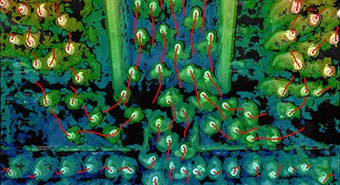The dynamics of pedestrians shows complex transport characteristics and interesting collective phenomena. A deeper understanding is the basis for optimizing buildings and facilities for pedestrian traffic in terms of both safety and economy and helps to increase comfort for users. In buildings for large numbers of people (arenas, theaters, etc.) and transport infrastructures (railway stations, airports, etc.), traffic routes, in particular escape and rescue routes as safety-relevant infrastructures, are of great importance.

Our aim is the quantitative description of pedestrian dynamics by investigating influencing aspects. Controlled reproducible experiments allow this and enable the analysis of selected parameters under well-defined constant conditions. Data of these experiments is collected and analyzed by appropriately selected sensors and self-developed software. Our group has taken on a pioneering role in the realization of large-scale laboratory experiments with pedestrians.
To increase the transparency of the research activities and promote a sustainable development, the analysis tools and self-developed data extraction software are freely available as well as the collected data itself.
Further Information
Project CroMa: Seeking Solutions to Overcrowding at Train Stations

